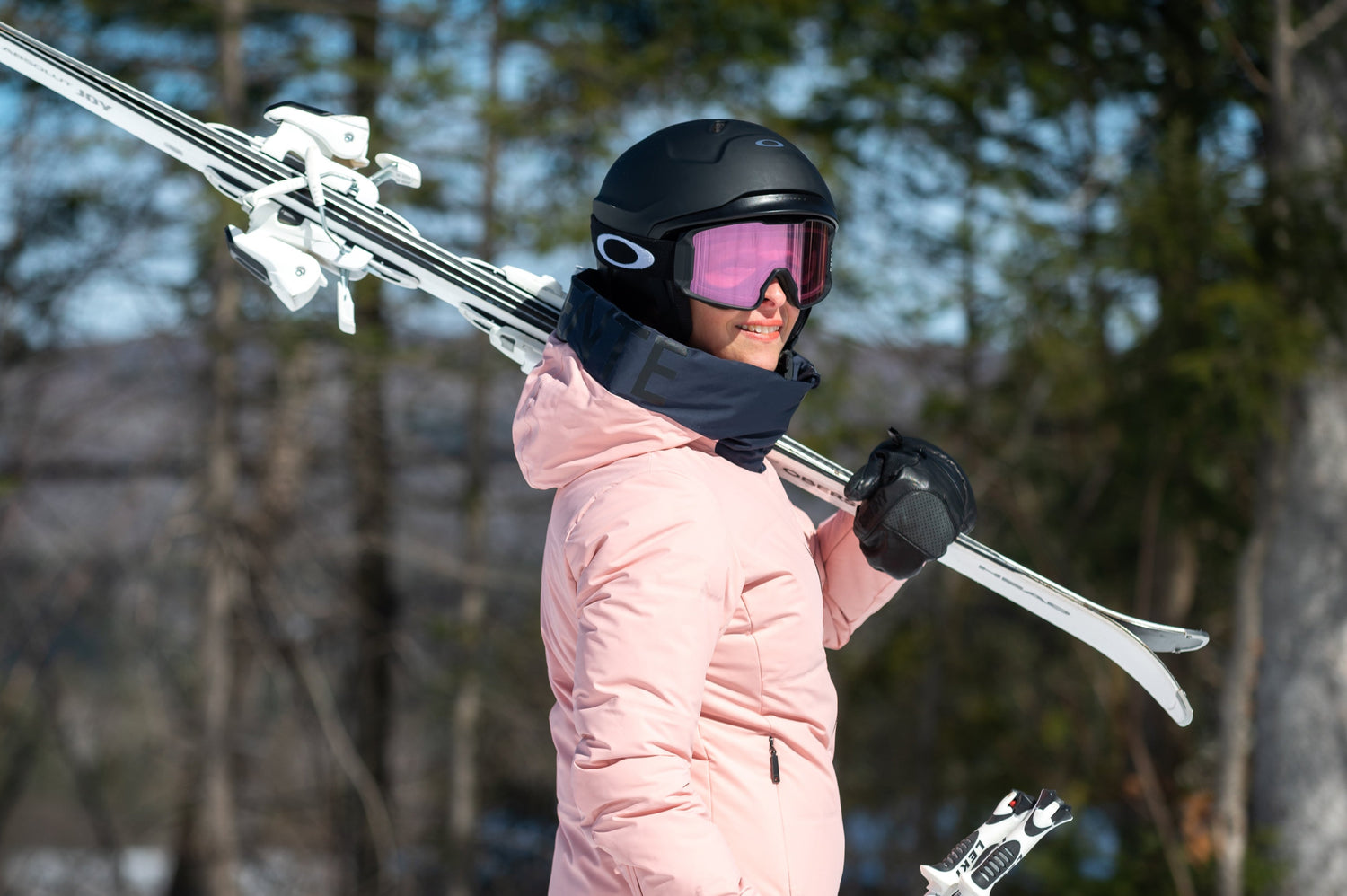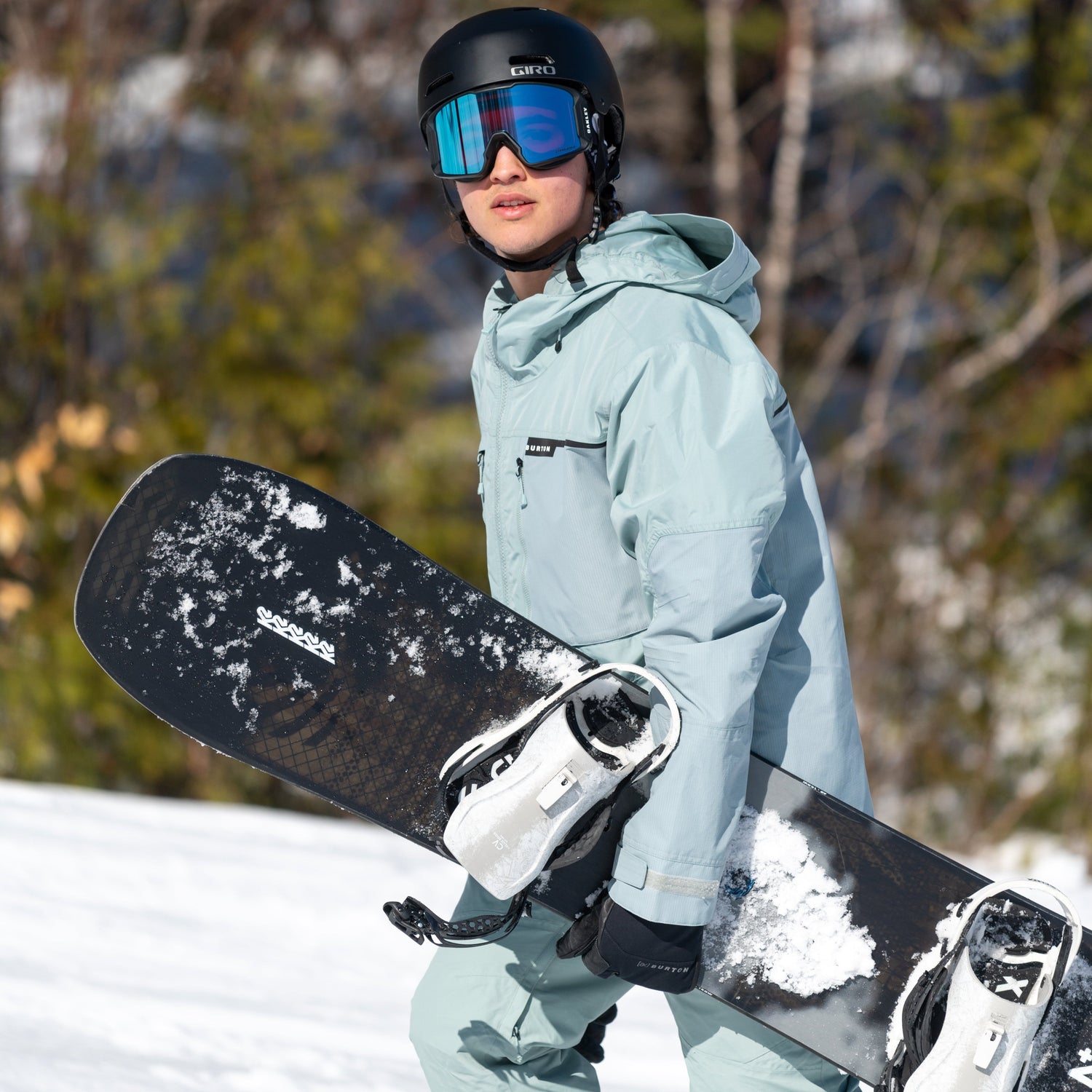What is a splitboard?
Riding fresh powder far from crowds and lineups. That’s what splitboarding promises! Like its name implies: it splits in half lengthwise to transform into skis that will take you to new summits by helping you climb. Once you’ve reached your goal, it turns back into a board thanks to the Karakoram clips. In just a few minutes, you can get on your board and have fun riding the fresh powder!

What are the different types of splitboards?
Just like a normal snowboard, there are different types of profiles. First, think about the kind of terrain you will normally ride.
If your your budget permits (and based on your objectives), you can put together a quiver for different kinds of outings:
All-Mountain Splitboard
The best choice for most riders in the East, it can be your quiver of one.
- Directional or twin, depending on your usual resort-riding style
- Shapes vary: camber, hybrid camber-rocker ou directional rocker
- Stability and edge hold on hardpack with manoeuvrability in softer snow
Powder Splitboard
Perfect after snowstorms, your trackless pow stash in the woods, and places like Western Canada.
- Wide, rockered nose with a narrower tail
- Directional shape
- Pronounced rocker at the front to float and pivot with ease
- Sometimes shorter but wider to maximize flotation
- Surfy feel
Freeride Splitboard
For riders tackling steep lines and variable conditions, a directional, stiff board delivers precision, stability, and dependable control in technical terrain.
- Camber under your back foot — More power and edge hold on steep slopes
- Rocker in the nose — Helps you stay on top of deep snow
- Stiffer flex — Stability at high speeds and in variable snow
- Directional shape — Improved edge hold and optimized downhill performance
Mountaineering Splitboard
Perfect for long ascents, big elevation gains, and high-mountain missions.
- Lightweight build (carbon or fibreglass) so you save energy on the climb
- Directional shape for more stability
- Camber or camber-rocker for stronger edge hold and icy traverses
- Less playful on the way down but very efficient on the way up
To learn more about snowboard profiles, check out our article "How to Choose the Right Snowboard Profile?".

The Splitboard Bindings
Splitboard specific bindings are different from your normal snowboard bindings. Elles sont légères, offrent une bonne mobilité à la montée et doivent être compatibles avec un système de rondelles (comme l’ensemble Voile) installé sur la planche.
-
Légèreté pour des montées plus faciles
-
Mobilité efficace grâce au pivot sous l’avant-pied
-
Passage rapide entre le mode marche et le mode descente
-
Cales de montée — petites pièces qui se basculent sous le talon pour réduire l’effort lors des pentes raides
Quelques exemples
-
Burton Hitchhiker — Talonnière intégrée qui offre plusieurs positions de montée. Compatible avec le système de rondelles lorsqu’on repasse en mode descente.
-
K2 Far Out — Talonnière simple et efficace directement sur les rondelles et système à crochets plutôt qu’embouts métalliques.

The Splitboard Boots
The nice thing about splitboarding is that there is no need for special boots. Therefore, the boots you usually wear can be used in the backcountry. However, if you wear very soft boots, it would be preferable to opt for a stiffer model that offers better support.
In the last few years, splitboard specific boots were introduced to the market. Good examples of innovation are the Burton Tourist or the Thirty-Two Jones MTB. The interesting feature of splitboard specific boots is that their sole has more grip, like Vibram soles.
- Medium to stiff flex — offers better support
- Grippy soles (e.g. Vibram) — for traction on hardpack
- Articulated cuff — makes long climbs easier

Splitboard Skins
Essential for this sport, skins are made with synthetic fibers, mohair or a mix of both, they allow for a fluid descent while being efficient on the climb. Skins are stuck to the base of the board, once it’s split, and attached to both extremities with a clip system. The adherence they offer will allow you to explore the backcountry and climb trails. On icy, wet, or hard slopes, you may need to use splitboard crampons. They clip into your bindings to provide extra grip when your skins start to slip. It’s an essential piece of gear to have on hand for more technical conditions (usually above treeline), especially in Gaspésie or out West.
To extend the lifespan of your climbing skins, make sure to dry them properly. After a tour, avoid leaving them to dry vertically on your skis in direct sunlight or warm temperatures. Once you’re home, hang them to dry at room temperature—never beside a woodstove or other direct heat source. Excessive heat can damage the glue. At the end of the season, store them in their bag, in a cool, dry, dark place.
Learn more about climbing skins in out article "How to Choose Climbing Skins?".

Adjustable Poles for Splitboard
Choosing well is of utmost importance! Telescopic poles will help you on the climb and to get around, they will also help you adapt to the terrain. Don’t forget, snowboarders don’t need them on the way down! Therefore, they need to be small enough that once retracted they fit in your backpack or can be hung from it without being in the way. Black Diamond poles are always a very good choice.

Touring Backpacks
For splitboarding, a good backpack really makes all the difference. It carries your water, food, clothing, tools, and safety gear and keeps it all organized and easy to access.
Your touring backpack should have the following:
- Minimum 30-litre capacity — enough room for water, clothing, accessories, and safety gear
- Dedicated compartments — including one for your shovel and probe
- Durability and weather resistance
- Comfort and stability — a padded hip belt, shoulder straps, and back panel for long climbs
- Board-carry system — useful for bootpacking
- External helmet carrying system — frees up space inside your pack
- Additional attachment points — ice-axe loop, side straps, and more depending on your objectives
Useful tip:
- Always carry a tool kit in your backpack.
- Also bring a first-aid kit.

How to dress for splitboarding?
For this high intensity sport, layering, top and bottom, is your best option.
The three layers in the system:
- Breathable base layer — synthetic or merino, which wick moisture and dry quickly
- Mid layer — synthetic insulation for breathability during high-output climbs
- Waterproof, breathable shell — windproof, snowproof, and designed to regulate moisture
Important accessories:
- Spare gloves, beanie, and neck warmers — to stay warm after the climb
- Lightweight gloves for the ascent, insulated mittens for the descent
- Technical touring socks
To learn more about layering, read our article How to Dress for Ski Touring?.
FAQ — Splitboard
Do I need to take an avalanche safety class to go splitboarding?
Not necessarily, since many ski resorts in Quebec offer marked skin trails for splitboarding and ski touring. However, if you plan to explore the backcountry, avalanche safety training (such as Avalanche Canada’s AST 1) is essential. You’ll learn how to assess terrain, recognize hazardous conditions, plan your route, and effectively use your beacon, shovel, and probe.
Can you put climbing skins on your splitboard before getting to the mountain?
Yes, if the drive is short and the weather is cold, you can put them on at home to save a bit of time and avoid frozen fingers in the parking lot. But for longer trips, it’s best to leave them in their bag. Heat inside the car can affect the glue, cause residue to stick to the base, and reduce adhesion. It’s best put them on once you’re there, right before you start your climb.
Can a splitboard be used for lift-served resort riding?
Yes, you can, but it won’t perform as well as a traditional snowboard. A splitboard doesn’t dampen vibrations quite as effectively on firm snow and has a different feel underfoot. If you spend a lot of time riding at the resort, a regular board will be a better fit. That said, many splitboards really shine on pow days.
Where are the best spots to start splitboarding in Quebec?
To get started splitboarding in Quebec, it’s best to begin at a resort that offers marked skin trails. This lets you get acquainted with your gear and gain experience in a comfortable, safe environment. Mont Avalanche in the Laurentians or Ski La Réserve in Saint-Donat would be solid choices. Once you’re ready, you can venture into beginner-friendly backcountry zones, such as Saint-Alex-Ski in Mauricie or Sentiers du Moulin in the Quebec City area. If you’d like more suggestions, check out our article “9 Places in Quebec to Start Alpine Touring.” More experienced riders can find ideas for outings in our article “7 Epic Alpine Touring Destinations in Quebec.”



